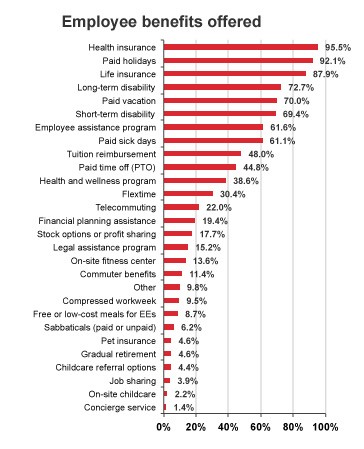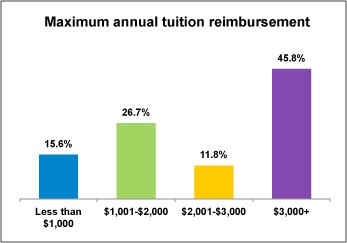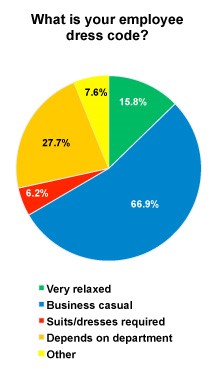Benefits—they can be great assets to your recruiting program and boost your overall compensation package, but employers have to be ever mindful of costs. Read the results of our Perks and Insurance Survey to see how your practices compare with what other companies are doing.
 |
Highlights of the 2015 Perks and Insurance Survey:
- The most common benefit offered by employers is health insurance, while the least-offered option is concierge services.
- Telecommuting is offered as a perk by 37.5% of respondents.
- The Patient Protection and Affordable Care Act (PPACA) caused 2015 insurance costs to increase for 54.5% of our survey participants.
- Among employers that offer tuition reimbursement, 30.7% consider it as important or very important to their recruiting and retention efforts.
Thanks to all 1,401 individuals who participated in the survey! Here are the detailed responses.
Survey Participants
Organizations with up to 250 employees account for 62.1% of our survey participants and 20.6% have 251 to 1,000 employees. Another 17.2% work in organizations with more than 1,000 employees.
Privately held for-profit organizations are represented by 60.5% of survey participants and privately held nonprofits account for 20.4%. The public sector makes up 19.2%. Industries include manufacturing (16.7%); health care and social assistance (13.7%); finance and insurance (9.2%); and professional, technical, and scientific services (9.6%). Educational services represent 5.8% of our survey participants and retail trade accounts for 3.5%.

Our 1,401 survey participants include those in staff positions (15.4%), supervisors (3.9%), manager or director level (64.3%), and VP or above (16.4%).
2015 Perks and Insurance Survey
From health insurance to stock options to paid vacation, today’s workforce expects to receive perks. All employers, however, do not provide them. At 95.5%, health insurance is the number one perk provided by participants in this survey, followed by paid holidays (92.1%) and life insurance (87.9%). Long-term disability comes in fourth at 72.7% and paid vacation is provided by 70%. Rounding out the top 10 benefits is short-term disability (69.4%), employee assistance programs (61.6%), paid sick days (61.1%), tuition reimbursement (48%), and PTO plans (44.8%).

At the other end of the spectrum, the least-offered benefit is concierge service at 1.4%. The bottom five benefits also include on-site child care (2.2%), job sharing (3.9%), childcare referral options (4.4%), and gradual retirement (4.6%).
Supplemental Insurance
Voluntary supplemental insurance plans offered to employees include dental insurance, topping the list at 90.2% of employers, and vision insurance, coming in second at 78.1%. Accident insurance is next at 60.1%. Lump sum cancer or critical illness insurance is offered by 52.7% and the least-offered supplemental benefit is Medicare supplement by 5.5% of the employers responding to our survey.
Are you plugged into the best sources for interviews and hires? Start on Wednesday, May 27, 2015, with a free interactive webcast from SilkRoad, Top Sources of Hire: A Look at the Definitive Report on Talent Acquisition Strategies. Learn More
Tuition Reimbursement
Tuition reimbursement is a benefit for 52.5% of survey participants and 21.9% offer it to part-time employees as well. Of those that offer this benefit, 30.7% consider tuition reimbursement important or very important to their recruiting and retention efforts.
Less than a year of employment is required for employees to be eligible at 40.5% and at least 1 year is required for 51.3%. The maximum annual amount of tuition reimbursement is less than $1,000 for 15.6% of survey participants. It is up to $2,000 for 26.7% and as much as $3,000 for 11.8% of employers. The reimbursement level is

Repayment of tuition reimbursement is never required by 26.9% of employers, even if the employee leaves the company. Repayment is required on a case-by-case basis for 14.6%. It depends on the timing of the departure for 56%.
Telecommuting
Telecommuting benefits are provided by 37.5% of survey participants with 44.2% of that group indicating they offer the benefit because it improves employee morale. Improved recruiting and retention is realized by 36.1%. Telecommuting reduces absenteeism for 25.5% and reduces infrastructure expenses for 17.3%. Higher employee productivity is a benefit of telecommuting for 43.6% of employers.

Formal telecommuting agreements are required by 29%. Those agreements cover performance criteria (63.3%), equipment requirements (62.8%), hours of work (54.4%), and “checking-in” (53.3%). An “at-will” disclaimer is included by 35.6% and environmental requirements are specified by 48.3%.
An allowance to cover employee expenses for setting up telecommuting at their home is provided by 14.6%, with 70.1% reimbursing telecommuting employees for monthly Internet connections and 66.7% reimbursing for telephone expenses.
Of those that offer this benefit, 39.7% consider telecommuting to be important or very important to their recruiting and retention efforts. Some survey participants, however, have concerns regarding their telecommuting programs, including:
- Employee management (out of sight, out of mind), 44.4%
- Monitoring productivity (are they really working?), 56.7%
- Effective two-way communication, 24.3%
- Scheduling meetings with telecommuters, 21.6%
- Inadequate technology, 8.6%
- Security risks (data breach during information transit), 20.5%
- Liability for employee accidents while working at home, 13.1%
- Increased costs to employer, 3.4%
- Morale issues of employees not eligible for telecommuting, 39.9%
Competition is fierce for talent—ensure you come out on top. Join us for a free interactive webcast, Top Sources of Hire: A Look at the Definitive Report on Talent Acquisition Strategies. Earn 1 hour in HRCI Recertification Credit. Register Now
Dress Codes
Dress codes are in place for 79.5% of survey participants, with 66.9% of them opting for business casual and “very relaxed” as the norm for 15.8%. The matter of dress is left up to departments for 27.7% but it’s strictly suits for 6.2% (less than 1% in 2014). Of those who have them, their dress code is considered important or very important to recruiting and retention for 23.1%.

Their dress code is relaxed during the summer months for 32.7% of survey participants. Dress-down days are offered by 79.2% but only for employees with no customer contact for 12.2%. Friday casual is the norm for 43.7% but only on or near holidays for 15.3%. Dress-down is a reward for performance or fundraising for 8.8%.
In tomorrow’s Advisor, more results of the Perks and Insurance Survey, plus we will introduce you to the free webcast from SilkRoad, Top Sources of Hire: A Look at the Definitive Report on Talent Acquisition Strategies.
